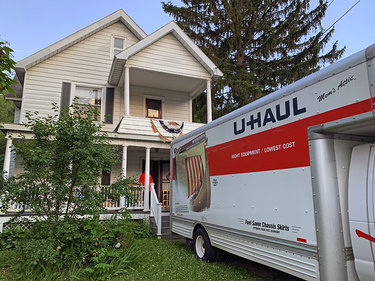Rezone redux: Stewart’s reapplies to village board as lawsuit hovers
— Photo from Carol Rothenberg
Movin’ on: The Tyson Family, who called 107-109 Helderberg Ave. home for 17 years, moved out of the duplex on July 1. In December 2018, the Altamont Village Board rezoned the property so that Stewart’s Shops, the owner of the home, could expand its adjacent shop.
ALTAMONT — A lawsuit filed by a group of Altamont residents against the village’s board of trustees and Stewart’s Shops has prompted the company to reapply for a zoning change that was already approved by the village board last December.
In doing so, the company and village board will be able to address one of the two bases of the lawsuit: That the board of trustees failed to comply with the State Environmental Quality Review process.
On Wednesday, The Enterprise was told by Gary Bowitch, the attorney for Concerned Severson Neighbors, the group that filed the suit, that the “parties are in the process of working on an adjournment,” or putting off until a later date, the lawsuit. The Enterprise reported in May that a trial date had been set for Aug. 1.
Asked if another date had been set for trial, Bowitch would not comment.
Should an adjournment be agreed upon, Chuck Marshall, a real-estate representative for Stewart’s, told The Enterprise, it could allow the project’s approval process to play out in it entirety — village-board approval of the zoning change, zoning-board approval of any variance requests, and planning-board approval of a site plan — which could address the complaints laid out in the lawsuit.
On Dec. 12, 2018, the village board voted, 3 to 2, to rezone 107-109 Helderberg Ave., from residential to commercial, which paved the way for Stewart’s to build a new shop on the site. Since then, a village election that largely turned on the rezone issue, and split the voting public nearly in half, returned to the board two trustees who had voted in favor of the rezone, Nicholas Fahrenkopf and Michelle Ganance. Mayor Kerry Dineen had also voted for the rezone, while trustees John Scally and Dean Whalen voted against it. The same rezone request had been rejected by the village board, in another split vote, two years prior.
At its July meeting, the village board set a public hearing for Sept. 3, to take up for the second time in seven months Stewart’s application to have 107-109 Helderberg Ave. The family that had lived in the duplex for 17 years moved out on July 1.
“As the Village Board is well aware, the previous zoning amendment process resulted in a rezoning of 107-109 Helderberg Avenue. However, litigation has since been commenced by one or more Village residents who has criticized technical aspects of the Board’s review process,” Stewart’s says in its application for the rezone request. “Stewart’s does not share these views. However, given the nature of the legal arguments raised, it seems that the most appropriate and effective way to address these concerns is through further review.”
Stewart’s also asked that the village board refer the application to the planning board for its comments. The planning board meets on Monday, July 22.
Should the village board again approve the rezone, Stewart’s would have to go back to the zoning board for variances based on the project’s designation as a gasoline service station, which the zoning board had said was the project’s proper designation, meaning that Stewart’s has to come up with a proposed plan that fits within the narrower code requirements of a gasoline service station.
Before it was announced that both sides were working on an adjournment of the lawsuit, Mayor Kerry Dineen was asked for comment about Stewart’s decision to reapply for an already-approved zoning change. Dineen, responding to The Enterprise in an email, said, “Because the matter is in litigation, on the advice of our attorneys I don't have any comment at this time.”
Michael Ginley, general counsel for Stewart’s Shops, did not return a call seeking comment. Leah Everhart, an attorney with Miller, Mannix, Schachner, and Hafner, the legal counsel for Stewart’s Shops, did not return a call seeking comment.
There are two core components to the petition filed by the Concerned Severson Neighbors with the Albany County Supreme Court in April: To annul and vacate the December 2018 law, because the village board violated state law by segmenting the SEQR process by only considering the potential impact rezoning 107-109 Helderberg Ave. would have, and not taking into consideration the potential environmental impact the construction of a new store would have.
And second, that the zoning of 107-109 Helderberg Ave. be reverted back to its original residential designation because, as a commercially-zoned parcel, it was not in accordance with the village’s comprehensive plan, and, therefore, a case of illegal spot zoning.
On Sept. 3, the village board gets a do-over at the first component of the lawsuit.
Setting straight SEQR
In its first application requesting a rezone, Stewart’s stated that the proposed action it was seeking would: “Rezon[e] from R-10 to Central Business District [107-109 Helderberg Ave.] and Construct Stewart’s Shop convenience store and self-serve gas.”
At the December 2018 village-board meeting, where the rezone of 107-109 Helderberg Ave. was approved, the board of trustees had determined that it could not complete its SEQR review on the proposed zoning change as well as the construction of a new shop because Stewart’s had not submitted a completed site plan. In its second application, the company submitted all the information the village board would need to make a SEQRA determination.
By only looking at the impact of the proposed zoning amendment, while allowing the planning board to eventually review a more complete site plan, the board chose, in the words of the Concerned Severson Neighbors lawsuit, to “segment” its SEQR review. Segmentation, according to the New York State Department of Environmental Conservation, “is defined as the division of the environmental review of an action so that various activities or stages are addressed as though they were independent, unrelated activities needing individual determinations of significance.”
Where the village board ran into trouble was that it appointed itself the project’s lead agency, whose purpose is to coordinate the SEQR process. A lead agency, according to the Department of Environmental Conservation, cannot delegate any of its determinations to another agency, which, according to the lawsuit, is what the village board did when it said it would delegate to the planning board the site-plan review.
The village board, it would appear, was aware of the problem of segmenting SEQR review.
In its second application request for a rezone, Stewart’s had included as part of its submittal package an analysis of the proposed rezone performed by Nan Stolzenburg, the village’s planning consultant, “during a previous consideration of a similar application.”
In her analysis, Stolzenburg brought up that both the rezone and site plan review are subject to the SEQR process, adding that the processes can’t be segmented.
She questioned whether a SEQR review of the rezone request could be performed without knowing more details about the physical project and its design, and came to the conclusion that “a full proposal for reconstruction … should be submitted so that the Village Board and everyone else knows what the actual project is so that the Village Board in its SEQR for the rezoning can ensure that the project will be compatible.”
Regarding Stolzenburg’s analysis and comments, The Enterprise wrote to Dineen: “According to Stewart’s application, Nan Stolzenburg, the village’s planning consultant, had, “during a previous consideration of a similar application,” said that SEQR process can’t be segmented, which, according to the lawsuit filed by the Concerned Severson Neighbors, it was. And when the board took up the rezone in December 2018, there was still some confusion about what it was voting on.”
Dineen was then asked: “Did the board ignore its own planning consultant, who had explained beforehand that the board couldn’t do what it did when it voted on the rezone in December 2018? If so, why?”
She responded: “Because the matter is in litigation, on the advice of our attorneys I don’t have any comment at this time.”
Spot zoning
The Concerned Severson Neighbors are also seeking to annul and vacate the village board’s decision to rezone from residential to commercial 107-109 Helderberg Ave., claiming that it is “not in accordance with the Village of Altamont Comprehensive Plan and is illegal ‘spot zoning.’”
Spot zoning, according to the New York Department of State, refers to the rezoning of a parcel of land to a use category different from the surrounding area, usually to benefit a single owner or a single development interest…” In the case of 107-109 Helderberg Ave., the parcel is directly adjacent to a commercially-zoned property. It is also directly adjacent to a residentially-zoned property. And spot zoning is considered illegal whenever the change is not “part of a well-considered and comprehensive plan calculated to serve the general welfare of the community,” according to settled case law.
The lawsuit also contends that the village board engaged in “ad hoc zoning” when it approved the zoning change because it was done for “the benefit of a single owner,” Stewart’s, and, “for a single purpose,” the construction of a new shop. That Stewart’s would benefit from the zoning change “will not on its own invalidate the action,” as long as the change “accords” with the village’s comprehensive plan, according to a state interpretation of the “landmark” spot-zoning case Rodgers versus the Village of Tarrytown.
In her analysis, Stolzenburg wrote that the rezone “may be consistent” with the village’s comprehensive plan because the plan states that it is the village’s goal to maintain the Central Business District — which now contains both Stewart’s and 107-109 Helderberg Ave. — “as the major location for retail and services” in Altamont.
Citing the village’s code, Stolzenburg wrote that the Central Business District was established “with the potential” for the village to extend it as long as it’s done in a way that “enhances the Main Street experience.”
New development in the village, Stolzenburg writes, should reflect Altamont’s existing architecture. In presentations, Stewart’s has shown renderings of its proposed store with a few architectural details meant to match those the neighboring Altamont Corners, which has some faux Victorian flourishes.
The comprehensive plan, Stolzenburg writes, explicitly states as one of its objectives strengthening the village’s “main streets,” specifically Main Street, Maple Avenue, and Prospect and Altamont boulevards. “[107-109 Helderberg Ave.] is immediately adjacent to the [Central Business District] and is at an intersection that is all business use,” she writes.
The village’s comprehensive plan, according to Stolzenburg, “does not map or specifically discuss extension” of the Central Business District to 107-109 Helderberg Ave., however, the rezone could be consistent with the comprehensive plan if Stewart’s new shop, among other things, met all the village’s zoning requirements and is designed to match the existing architecture of nearby buildings.
Stolzenburg concluded, “It is my opinion, therefore, that the zoning change makes sense provided the site planning creates a new structure that meets all the other zoning requirements for design, lot layout, etc.”



